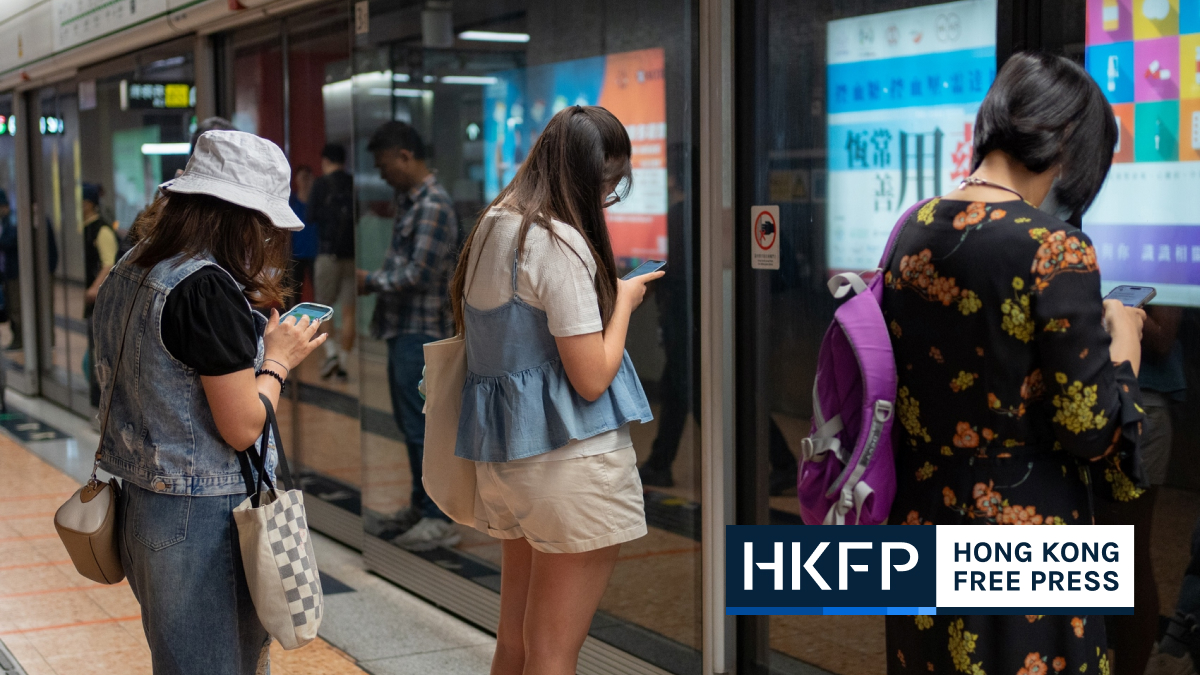For 66 straight weeks from September 2020 to last December, Ko Lap barely left his flat.
Every week, the artist delivered a new painting – each inspired by an original piece of writing – to Ming Pao’s Sunday supplement, along with the article, poem or short story that it emerged from.

Unlike most illustrations in print media nowadays, Ko’s pieces were all created with water paints instead of computer graphics. “If I am to make any changes, basically I have to paint it all over again,” he said.
To make room to paint, he had to get rid of two wardrobes and almost all of his clothes. He needed an entire wall to hang his canvases.
“Clothes were the easiest to throw away,” Ko said, as they carried little meaning to him, unlike books. That left Ko’s tiny flat barely furnished, with only his bed, a chair, a book shelf, a small cupboard that doubles as his table, and a shelf for his computer and TV.
Ko would usually spend Monday to Wednesday in communication with the writers and contemplating ideas for painting ideas.
In the remaining three days before Sunday, he would sleep for only a few hours and work tirelessly to finish each artwork – with the help of a constant stream of music, coffee and other caffeinated drinks.
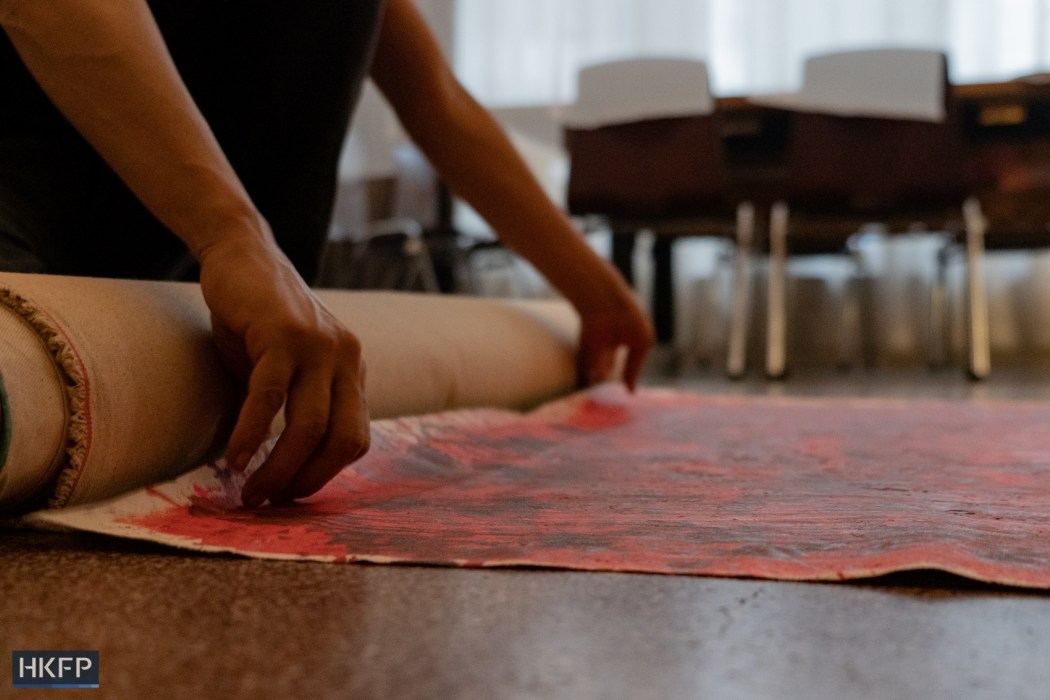
Ko, who uses a pseudonym, said the process of painting was very painful, but not because of the above reasons. The worst part, he said, is that it requires him to dive into the depths of his mind and face what people usually choose to avoid: “your own flaws, weaknesses, and dark side.”
“The difficulty is that you really need to dive into an ocean of trauma,” Ko said, “you will be horrified as you know it will be painful, but there is no other way.”
The painter said it was the only way for others to see his sincerity and resonate with his artworks.
Stand fast
Ko was in the middle of hosting a 21-day exhibition of his paintings for Sunday Mingpao at a gallery in Sham Shui Po when he met HKFP, and he said he had been almost sleepless preparing for the exhibition, as well as a number of media interviews.
But no matter how many times Ko has talked about his creations with reporters, he told HKFP that he would never get used to being interviewed. Ko said he was a very introverted person, and he would not usually speak when in a big group or with strangers.
During his interview, Ko often looked at the far side of the room while speaking, and only made eye contact when asking questions.

He even finds his paintings “embarrassing.” “Because you are basically naked in others’ eyes. You have to peel yourself back for people to watch,” he said, as his work expressed his deepest thoughts or emotions.
“But there’s no other way, I know I have to finish my job,” the painter said. “I need to make changes to myself to make things better.”
Ko was a graphic designer for most of his career. Then, in 2020, the artist’s life took a sharp turn. He quit his job and dedicated all his time and energy to this project.
He said he realised painting was his way of making his voice heard and “doing something.”
When painting, Ko first layers the canvas with plaster to allow the colours to flow freely through the rough surface. At this point in the creative process, Ko said he has no control over his work, and it felt like he was seeking divine advice.
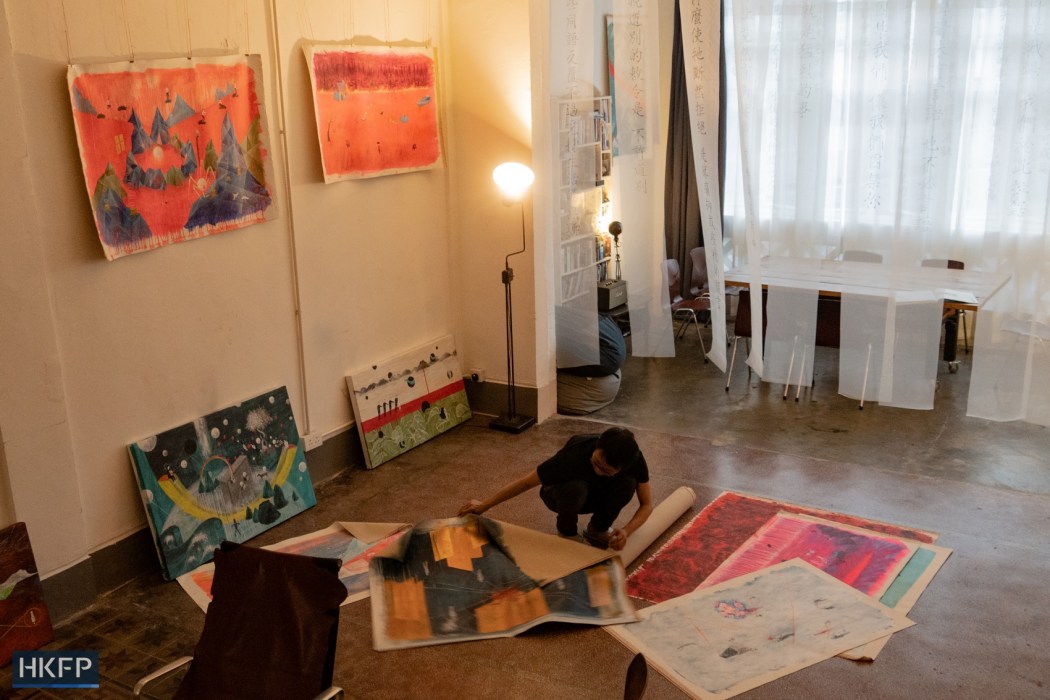
Fate is one of Ko’s main inspirations. “In this current era, [people] share a sense of powerlessness… one’s own strength cannot make much of a difference,” Ko said. “A lot of the time you can do nothing but give it your best try.”
The artist recalled an ancient tale he once heard, about a saint who, when asked what quality made him saintly, pointed at a young attendant who was serving tea politely and meticulously. “This here is a saint, because he was doing his best in his role,” the saint answered.
“We don’t need heroes. What we need is to stand fast and do the best that we can,” Ko said.

Because the Sham Shui Po gallery was not large enough to house all 64 paintings, Ko arranged a private space on the highest level of an old tenement building in Prince Edward so that his writer friends could see his work – that was where he met HKFP.
Despite not being open to the public, the artist still paid great attention to detail in its decoration.
A curtain of semi-translucent vertical banners bearing memorable sentences from the 64 writings that inspired his paintings separated the room in which his paintings hang. There was also a hand-carved revolving lamp to add to the atmosphere of the place – which took the painter days to make.
Connections
Ko’s position, he said, was that of a middleman between the 64 writers he collaborated with and Hongkongers who needed the company of their literature.
Every week during the months-long project, Ko reached out to a different author and invited them to write about the city. “Hope the theme is related to Hong Kong,” was all he told the writers.
To his astonishment, it seemed to him that everyone had a tacit understanding of what to write about. Ko said the collaborations made him feel like Hongkongers had become more connected with each other in recent years because of the social atmosphere.
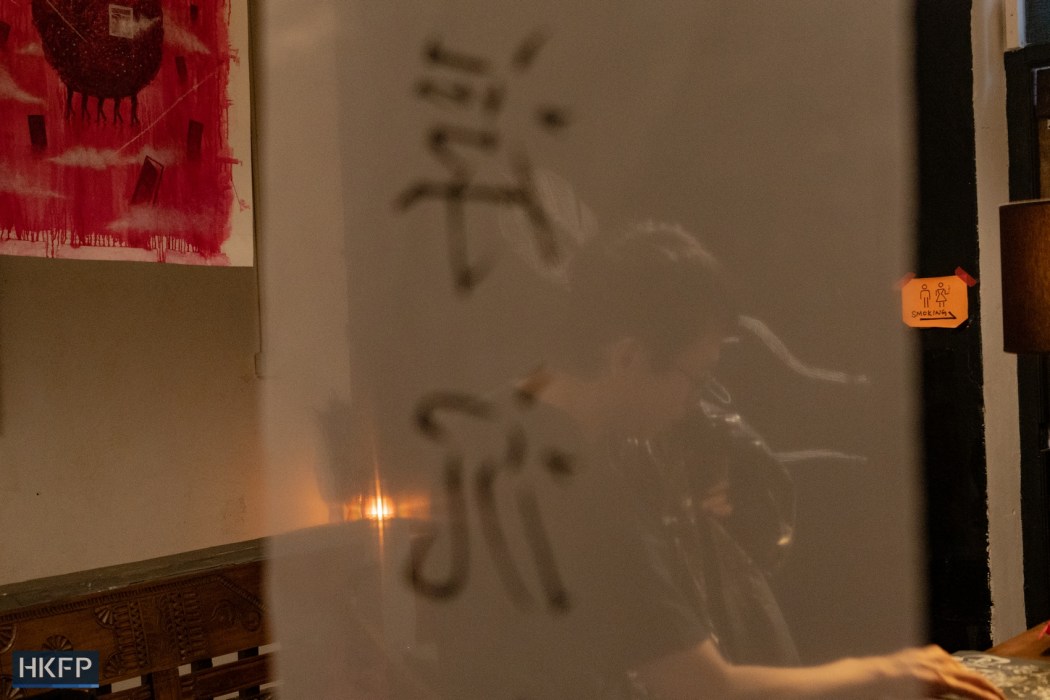
“Trauma became our mutual identity,” Ko said, adding that it was why his project went smoothly. In May, a book of his paintings and their accompanying writings was published. “Many people are supporting us, a lot of bookstores wrote commentaries to recommend our new book as well,” he said.
The connections between Ko’s paintings and the writers’ literary works go beneath the surface. Ko said he intentionally avoided simply illustrating whatever the author was writing about, because he felt it would not have added an extra layer of meaning.
Instead, Ko would spend a few days going back and forth with the writer to grasp the hidden message they wanted to convey, then respond with his artworks. “It was like chatting with a friend,” Ko said.
While explaining his creative process, he stood up and pointed at one of his paintings on the wall. The work, titled “Mobius ring,” depicts a forest with blood veins as “trees” and a human heart lying in the middle of a pond at the centre. The scene is dominated by a sharp crimson tone, in which a white circular swing park and few human and animal figures stand out.
It was his response to a piece written by Wong Pik-wai, one of the rising names in Hong Kong’s literature scene, that Ko highly appreciated.
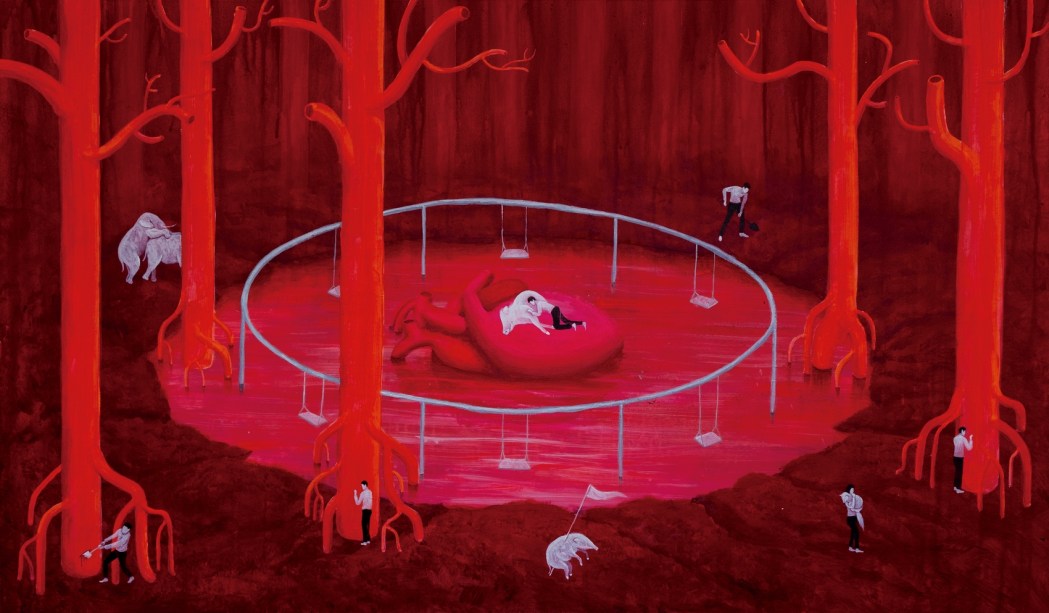
Wong wrote about the redevelopment of Kwun Tong, but through their conversations, Ko learned that the sense of loss at the centre of her story actually stemmed from a childhood experience. Wong was unable to visit a playground when she was a girl and the feeling has since stuck in her mind.
“You have to speak with her heart to heart, only then you will understand that she was not really talking about the redevelopment itself,” Ko said. “So I deliberately drew a playground for her.”
Ko said he hoped when Wong saw this painting, she would see what was deeply buried in her heart, and the conversation they had could act as a form of healing for both creators.
Power of tenderness
Although human emotions are a major component of Ko’s artwork, the humans depicted in his painting are always very small. These figures are also faceless, their emotions expressed only through their body language.
Ko said he was largely inspired by the late German dancer and choreographer Pina Bausch, who he said was great at turning everyday gestures into artistic expressions. Ko said his job as painter was also to feel the emotions behind people’s body movements.
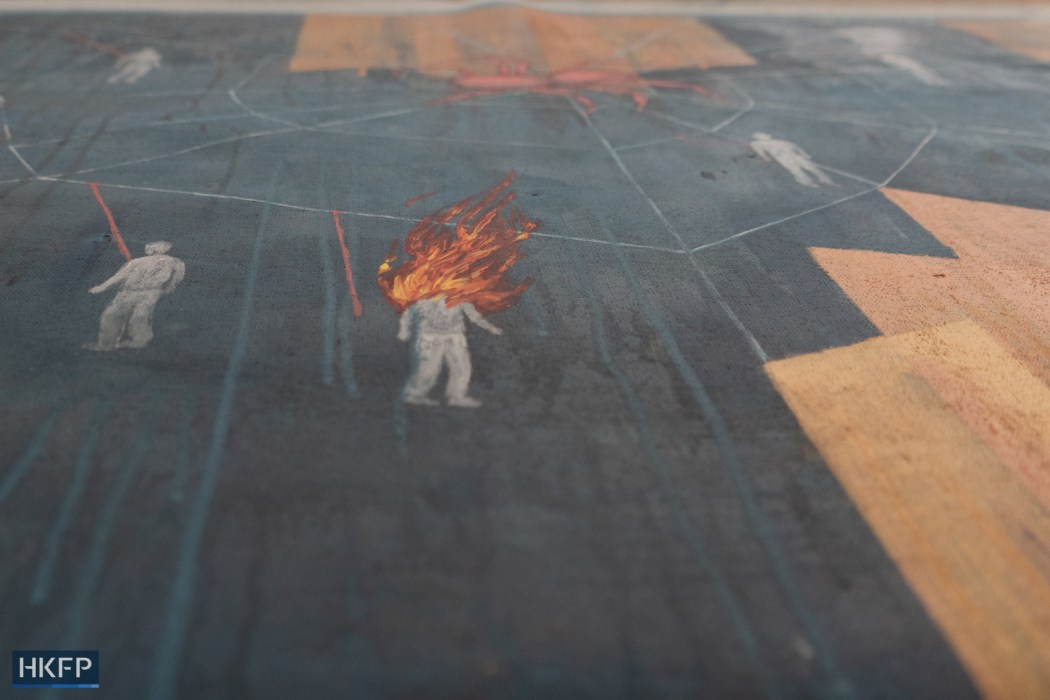
When Ko invited Ricky Yeung, a heavyweight of the local art scene, to write the preface for his new book, Yeung also noticed the unique perspective in Ko’s work and his presentation of human characters.
“Ko Lap seemed to want to prevent the audience from entering the scene, and instead ‘calmly’ observe the world,” Yeung wrote, adding that viewers of Ko’s paintings would feel like angels gazing at all living beings while standing on top of a skyscraper.
Ko said he loved Yeung’s description and it was his intention for his work to not carry any extreme emotions. “I hope [my work] is gentle. I believe in the power of tenderness, which brings hope and love,” Ko said.
“If [I] drew some sensational stuff, all I did was tell you a message,” Ko added.
Instead, the painter said his aspiration was not to tell readers anything, but help them to see their own trauma.
“When you bravely face the painful reality, you can feel that you are healed somehow,” he said.
Support HKFP | Policies & Ethics | Error/typo? | Contact Us | Newsletter | Transparency & Annual Report | Apps
Help safeguard press freedom & keep HKFP free for all readers by supporting our team

LATEST FROM HKFP
HKFP has an impartial stance, transparent funding, and balanced coverage guided by an Ethics Code and Corrections Policy.
Support press freedom & help us surpass 1,000 monthly Patrons: 100% independent, governed by an ethics code & not-for-profit.







